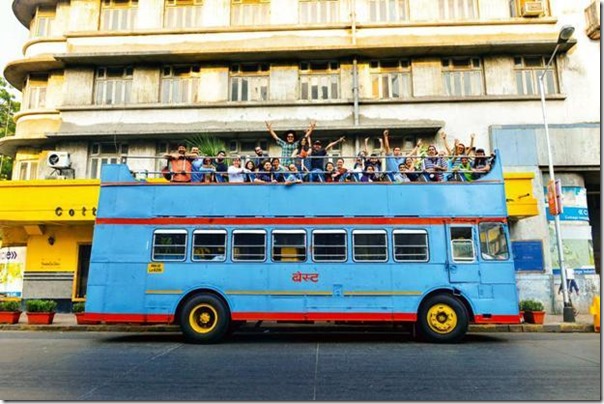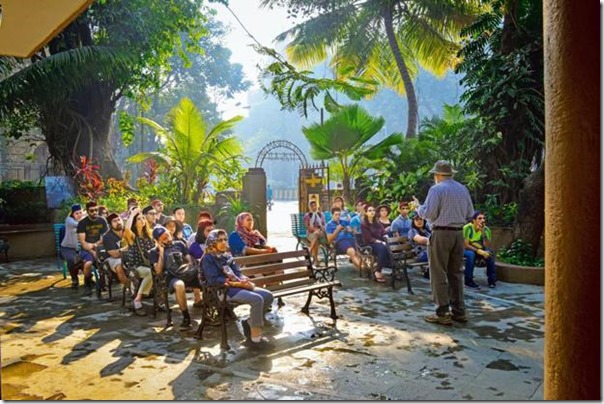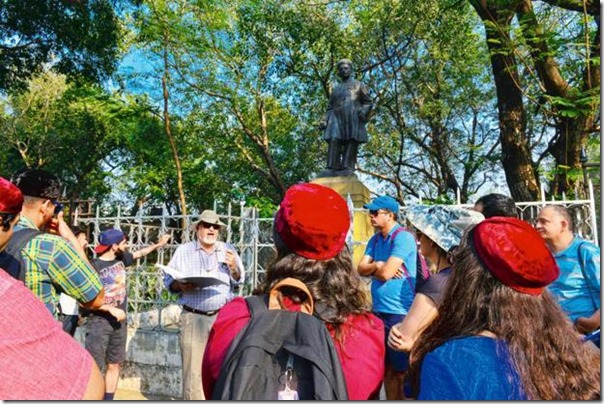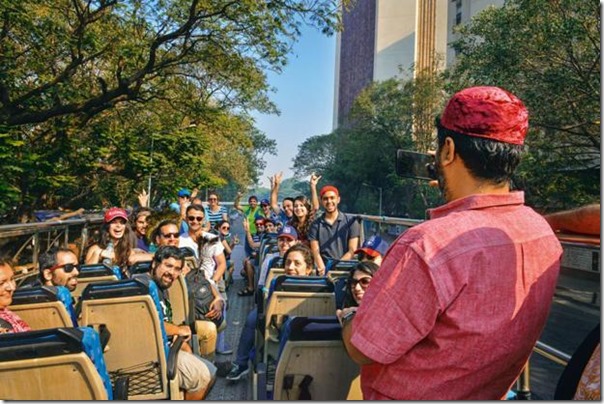An annual tour is bringing together young Zoroastrians from across the world to explore their culture in India and even find a partner
Return To Roots fellows on a BEST, Mumbai. Photo: Aniruddha Chowdhury/Mint
As the tall blue bus rounds the corner of Mumbai’s Crawford Market on to Mohammed Ali Road, the Sunday morning street traders squint up at the tourists assembled on its open upper deck. Some of them wave, and one guy blows a cheerful kiss to the 22-year-old American with a camera strapped around her neck. She returns the gesture, laughing.
Article by Supriya Nair | Mint
“There’s the husband your family wanted you to find on this trip,” one of the other girls jokes. “It can’t be,” the 22-year-old shoots back, mouth curving. “He’s not Parsi!”
They are a gathering of nearly two dozen young Zoroastrians who have never lived in India. Some, born in Iran, aren’t even Parsi, a word which defines a subcontinental social group. They’re at the end of a fortnight-long trip, part of Return To Roots (RTR), an annual programme run by their co-religionists to give diaspora youth—anywhere between the ages of 22 and 35—an anchor in the nerve centre of Zoroastrianism, on the western coast of India.
The group at the Bhikha Behram, Mumbai
There may be fewer than 200,000 Zoroastrians in the world, by some accounts. The 2011 census of India indicated that just under 60,000 live in India. Most live in Mumbai, where they grew to be a dominant force in public life under British rule; and in Gujarat, where the first immigrants landed, fleeing persecution in Iran between the eighth and 10th centuries AD. A second wave of “Iranis” arrived in the late 19th and early 20th centuries, escaping Qajar-era pogroms. Many of their descendants now live and work abroad, away from what the RTR programme director, Arzan Sam Wadia, a 44-year-old architect from New York, sometimes refers to as the “motherland”.
It was for such young Zoroastrians that RTR was conceived in 2012 by a group of young expatriate Zoroastrians, Wadia included, who met at a community event in New York. Wadia, a Parsi born and brought up in Mumbai, now leads the programme’s annual two-week trip. It is open to any young Zoroastrian who applies to join, and can cover, at least partially, the door-to-door cost of $5,000 (around Rs3 lakh) a head.
A kernel of inspiration comes from Israel, where the government helps run the “Birthright Israel” programme meant to inculcate the spirit of the Jewish homeland in young members of their diaspora, helping them understand both religion and culture, past and present. In contrast, RTR is privately funded by friends and well-wishers, of whom there are many among India’s wealthy Parsis (a previous group even managed a rendezvous with Ratan Tata, chairman emeritus of Tata Sons). It’s not a call to resurrect a glorious past, or take sides in ongoing Zoroastrian battles over issues that deeply affect the community, including its sharply dwindling numbers and strict laws governing marriage outside the faith.
“It’s some good news in the middle of all that,” Wadia says. “To see young people come together to explore their culture instead of more bickering.”
*****
The very first RTR fellowship took place in 2013, and included 14 young people. Some trips coincide with important events on the Parsi calendar. In 2015, they looped in a quick flight to Delhi to see four museum exhibits, including the National Museum’s landmark The Everlasting Flame: Zoroastrianism In History And Imagination, part of the ministry of culture’s spotlight on Zoroastrian religion and culture. The Union government’s efforts to preserve Parsi ways of life have not bypassed RTR. In December, minister for information and broadcasting Smriti Irani, who takes her Zoroastrian husband’s last name, even called out to the group in a speech at a festival held in the pilgrimage town of Udvada, Gujarat, home to the “Iranshah”, an ever-burning sacred fire said to have been brought to India from Iran in 715 AD.
The group at the statue of Hormusjee Cowasjee Dinshaw
The group, wearing “Return To Roots” T-shirts, was in the audience for that event, part of their tour of Parsi history. Before the tour wrapped up on 2 January, they had lunched in Mumbai’s legendary restaurant Jimmy Boy, and had dinner with the city’s splashy builder-baron Jimmy Mistry. They had dwelt on the fabulous nobility of the Parsi past in historic mansions in Surat and been to chikoo farms in Dahanu. They saw how the kusti, the traditional girdle worn to prayers, is made. They went to the Gujarati countryside to meet Parsi farmers living in tiny impoverished communities outside Navsari (the coastal city has a very old Parsi community), without the safety net the community provides to even the most penurious Parsis in Mumbai.
The double-decker bus tour through parts of South Mumbai was one of the last events on their schedule, designed to acquaint them with the high points of the city’s secular Parsi history. They gazed up at the statues of the Congress stalwart Dinshaw Vacha and the merchant prince Jamsetjee Jeejeebhoy at Churchgate, and the historic buildings of Dadabhai Naoroji Road. They attended respectfully to the walk leader, Parsi scholar Khojeste Mistree, as he delivered a talk at the sacred Bhikha Behram well, where some older Parsis could be seen praying privately behind them.
“We make it very clear that this is not a pilgrimage,” Wadia says. But of course, the tour is designed to inculcate a spirit of reverence for Parsi religious culture. How could it be otherwise in the presence of the atash behrams, the consecrated fires at the heart of the holiest Parsi temples, of which only nine remain in the world, eight of them in India (and four of those in Mumbai); or at Malabar Hill’s tower of silence, one of the last remaining places in the world where Zoroastrians may conduct the traditional funerary practice of exposing the dead to the elements?
The catch is that same rules apply to these young Zoroastrians as to any Parsis in India who want to enter a fire temple or perform acts of worship therein: their parents, or at least their fathers, must be of the faith. Khojeste Mistree is often quoted as an eminent conservative voice on these matters in the Parsi press, and an RTR participant, who preferred not to be named, told me that at the end of the bus tour walk, Mistree went up to many of the young visitors and told them, as though pronouncing a benediction: “You must marry within the community. You must marry within the community.”
*****
For generations, these strictures have divided Parsis, as is evident from the debates that still rage weekly in the pages of Mumbai’s Jam-e-Jamshed newspaper (or the comments section of Parsi Khabar, the website Wadia edits). They have also heartbreaking consequences for families.
Among the RTR fellows this year was 30-year-old Jasmine Baetz, a Canadian ceramic artist who lives and works in the US, and was visiting India for the first time. Baetz is married to an American; her Parsi mother was sundered from her orthodox roots in India for marrying, as Baetz puts it, “a dude from Ontario”. For Baetz, the return to India was an opportunity to learn about, and perhaps find connection with, a community that had seemed to reject and exclude her.
Arzan Sam Wadia taking a picture of the 2017 RTR fellows in Mumbai
Friends and relatives, some of them in their 80s, welcomed her into their homes. She’s eaten more Parsi food than her stomach can handle (Wadia told me that the programme supports as many Parsi-owned businesses as possible through its duration, which includes its hospitality and catering choices). She questioned the rules prohibiting fire temple entry and worship through the trip, but did not break them; nor did the RTR programme encourage circumvention.
“Change is coming to the community, and part of what we want to give young people on this tour is the full range of opinions on a lot of things that matter to us,” Wadia says. “But we’re also not going to break rules.”
“The community in North America may be much more liberal than what I’ve seen here,” Baetz says. This may be partially true. Even in Mumbai, where Parsi orthodoxy and Parsi power coincide, it’s possible to find liberal clerics to conduct a Navjote, the religious initiation, for children whose fathers are not Parsi—just as Baetz’s mother, finding no support among her co-religionists in Toronto, found a priest in California to do Baetz and her brother’s Navjote.
– Arzan Sam Wadia
There was one group of people for whom RTR was a homecoming in more than one sense—six young Karachiites, almost all of whom were on their fifth or sixth visit to India, where many have close family ties. The government’s pro-Parsi stance did not quite make the trip frictionless for Pakistani participants; at least one person got his visa mere hours before his flight was due.
They were not necessarily on this trip for a sense of renewal. Ancestral wealth and stately old relatives who pronounce “Tata” like “barter” are part of their own lives at home; sea-facing Mumbai apartments and the fire temples that dot the Gujarat coast mean childhood vacations, and meeting other young Parsis is often, as one young man said under his breath, about “finding a wife, wife, wife”. Welcome to the subcontinent. “There’s a lot of Parsi land and wealth in Pakistan,” Wadia says. “But there are 1,200 Parsis in Karachi. For them to come here and see those many Parsis just at one wedding at the Colaba agiary—that means something.”
Someday, Wadia hopes to take the programme to Pakistan and Iran— places central to Parsi history, and perhaps also portents of the community’s future in India. “Today, India has the largest population of Zoroastrians. What if, someday, that isn’t the case?” Wadia asks rhetorically. “What does the ‘motherland’ mean, then? What happens to everything of value here?” The answers are not easy, but the questions he hopes to provoke with this return to roots are meant to keep the flame alive.



